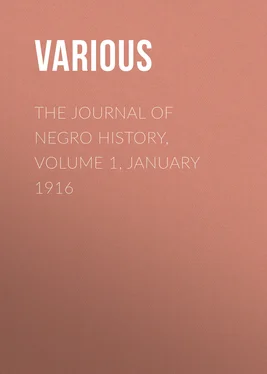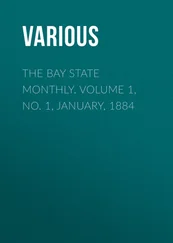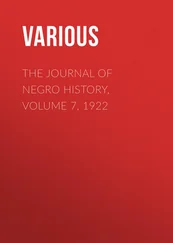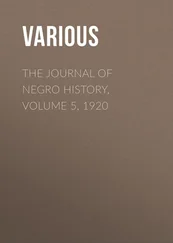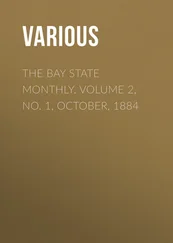Various - The Journal of Negro History, Volume 1, January 1916
Здесь есть возможность читать онлайн «Various - The Journal of Negro History, Volume 1, January 1916» — ознакомительный отрывок электронной книги совершенно бесплатно, а после прочтения отрывка купить полную версию. В некоторых случаях можно слушать аудио, скачать через торрент в формате fb2 и присутствует краткое содержание. Жанр: foreign_antique, periodic, История, foreign_edu, на английском языке. Описание произведения, (предисловие) а так же отзывы посетителей доступны на портале библиотеки ЛибКат.
- Название:The Journal of Negro History, Volume 1, January 1916
- Автор:
- Жанр:
- Год:неизвестен
- ISBN:нет данных
- Рейтинг книги:5 / 5. Голосов: 1
-
Избранное:Добавить в избранное
- Отзывы:
-
Ваша оценка:
- 100
- 1
- 2
- 3
- 4
- 5
The Journal of Negro History, Volume 1, January 1916: краткое содержание, описание и аннотация
Предлагаем к чтению аннотацию, описание, краткое содержание или предисловие (зависит от того, что написал сам автор книги «The Journal of Negro History, Volume 1, January 1916»). Если вы не нашли необходимую информацию о книге — напишите в комментариях, мы постараемся отыскать её.
The Journal of Negro History, Volume 1, January 1916 — читать онлайн ознакомительный отрывок
Ниже представлен текст книги, разбитый по страницам. Система сохранения места последней прочитанной страницы, позволяет с удобством читать онлайн бесплатно книгу «The Journal of Negro History, Volume 1, January 1916», без необходимости каждый раз заново искать на чём Вы остановились. Поставьте закладку, и сможете в любой момент перейти на страницу, на которой закончили чтение.
Интервал:
Закладка:
Various
The Journal of Negro History, Volume 1, January 1916
The Journal of Negro History
Vol. I., No. 1 January, 1916
The Negroes of Cincinnati Prior to the Civil War
The study of the history of the Negroes of Cincinnati is unusually important for the reason that from no other annals do we get such striking evidence that the colored people generally thrive when encouraged by their white neighbors. This story is otherwise significant when we consider the fact that about a fourth of the persons of color settling in the State of Ohio during the first half of the last century made their homes in this city. Situated on a north bend of the Ohio where commerce breaks bulk, Cincinnati rapidly developed, attracting both foreigners and Americans, among whom were not a few Negroes. Exactly how many persons of color were in this city during the first decade of the nineteenth century is not yet known. It has been said that there were no Negroes in Hamilton County in 1800. 1 1 Quillin, "The Color Line in Ohio," 18.
It is evident, too, that the real exodus of free Negroes and fugitives from the South to the Northwest Territory did not begin prior to 1815, although their attention had been earlier directed to this section as a more desirable place for colonization than the shores of Africa. 2 2 "Tyrannical Libertymen," 10-11; Locke, "Antislavery," 31-32; Branagan, "Serious Remonstrance," 18.
As the reaction following the era of good feeling toward the Negroes during the revolutionary period had not reached its climax free persons of color had been content to remain in the South. 3 3 Woodson, "The Education of the Negro Prior to 1861," 230-231.
The unexpected immigration of these Negroes into this section and the last bold effort made to drive them out marked epochs in their history in this city. The history of these people prior to the Civil War, therefore, falls into three periods, one of toleration from 1800 to 1826, one of persecution from 1826 to 1841, and one of amelioration from 1841 to 1861.
In the beginning the Negroes were not a live issue in Cincinnati. The question of their settlement in that community was debated but resulted in great diversity of opinion rather than a fixedness of judgment among the citizens. The question came up in the Constitutional Convention of 1802 and provoked some discussion, but reaching no decision, the convention simply left the Negroes out of the pale of the newly organized body politic, discriminating against them together with Indians and foreigners, by incorporating the word white into the fundamental law. 4 4 Constitution, Article I, Sections 2, 6.
The legislature to which the disposition of this question was left, however, took it up in 1804 to calm the fears of those who had more seriously considered the so-called menace of Negro immigration. This body enacted a law, providing that no Negro or mulatto should be allowed to remain permanently in that State, unless he could furnish a certificate of freedom issued by some court in the United States. Negroes then living there had to be registered before the following June, giving the names of their children. No man could employ a Negro who could not show such a certificate. Hiring a delinquent black or harboring or hindering the capture of a runaway was punishable by a fine of $50 and the owner of a fugitive thus illegally employed could recover fifty cents a day for the services of his slave. 5 5 Laws of Ohio, II, 63.
As the fear of Negro immigration increased the law of 1804 was found to be inadequate. In 1807, therefore, the legislature enacted another measure providing that no Negro should be permitted to settle in Ohio unless he could within twenty days give a bond to the amount of $500, guaranteeing his good behavior and support. The fine for concealing a fugitive was raised from $50 to $100, one half of which should go to the informer. Negro evidence against the white man was prohibited. 6 6 Laws of Ohio, V, 53.
This law together with that of 1830 making the Negro ineligible for service in the State militia, that of 1831 depriving persons of color of the privilege of serving upon juries, and that of 1838 prohibiting the education of colored children at the expense of the State, constituted what were known as the "Black Laws." 7 7 Hickok, "The Negro in Ohio," 41, 42.
Up to 1826, however, the Negroes of Cincinnati had not become a cause of much trouble. Very little mention of them is made in the records of this period. They were not wanted in this city but were tolerated as a negligible factor. D. B. Warden, a traveler through the West in 1819, observed that the blacks of Cincinnati were "good-humoured, garrulous, and profligate, generally disinclined to laborious occupations, and prone to the performance of light and menial drudgery." Here the traveler was taking effect for cause. "Some few," said he, "exercise the humbler trades, and some appear to have formed a correct conception of the objects and value of property, and are both industrious and economical. A large proportion of them are reputed, and perhaps correctly, to be habituated to petit larceny." But this had not become a grave offence, for he said that not more than one individual had been corporally punished by the courts since the settlement of the town. 8 8 Warden, "Statistical, Political and Historical Account of the United States of North America," 264.
When, however, the South reached the conclusion that free Negroes were an evil, and Quakers and philanthropists began to direct these unfortunates to the Northwest Territory for colonization, a great commotion arose in Southern Ohio and especially in Cincinnati. 9 9 Quillin, "The Color Line in Ohio," 32.
How rapid this movement was, may be best observed by noticing the statistics of this period. There were 337 Negroes in Ohio in 1800; 1,890 in 1810; 4,723 in 1820; 9,586 in 1830; 17,342 in 1840; and 25,279 in 1850. 10 10 The Census of the United States, from 1800 to 1850.
Now Cincinnati had 410 Negroes in 1819; 11 11 Flint's Letters in Thwaite's "Early Western Travels," IX, 239.
690 in 1826; 12 12 Cist, "Cincinnati in 1841," 37; Cincinnati Daily Gazette , Sept. 14, 1841.
2,255 in 1840; 13 13 Ibid.
and 3,237 in 1850. 14 14 United States Census, 1850.
It was during the period between 1826 and 1840 that Cincinnati had to grapple with the problem of the immigrating Negroes and the poor whites from the uplands of Virginia and Kentucky. With some ill-informed persons the question was whether that section should be settled by white men or Negroes. The situation became more alarming when the Southern philanthropic minority sometimes afforded a man like a master of Pittsylvania County, Virginia, who settled 70 freedmen in Lawrence County, Ohio, in one day. 15 15 Ohio State Journal , May 3, 1827; African Repository , III, 254.
It became unusually acute in Cincinnati because of the close social and commercial relations between that city and the slave States. Early in the nineteenth century Cincinnati became a manufacturing center to which the South learned to look for supplies of machinery, implements, furniture, and food. 16 16 Abdy, "Journal of a Tour in the United States," III, 62.
The business men prospering thereby were not advocates of slavery but rather than lose trade by acquiring the reputation of harboring fugitive slaves or frightening away whites by encouraging the immigration of Negroes, they began to assume the attitude of driving the latter from those parts.
Интервал:
Закладка:
Похожие книги на «The Journal of Negro History, Volume 1, January 1916»
Представляем Вашему вниманию похожие книги на «The Journal of Negro History, Volume 1, January 1916» списком для выбора. Мы отобрали схожую по названию и смыслу литературу в надежде предоставить читателям больше вариантов отыскать новые, интересные, ещё непрочитанные произведения.
Обсуждение, отзывы о книге «The Journal of Negro History, Volume 1, January 1916» и просто собственные мнения читателей. Оставьте ваши комментарии, напишите, что Вы думаете о произведении, его смысле или главных героях. Укажите что конкретно понравилось, а что нет, и почему Вы так считаете.
